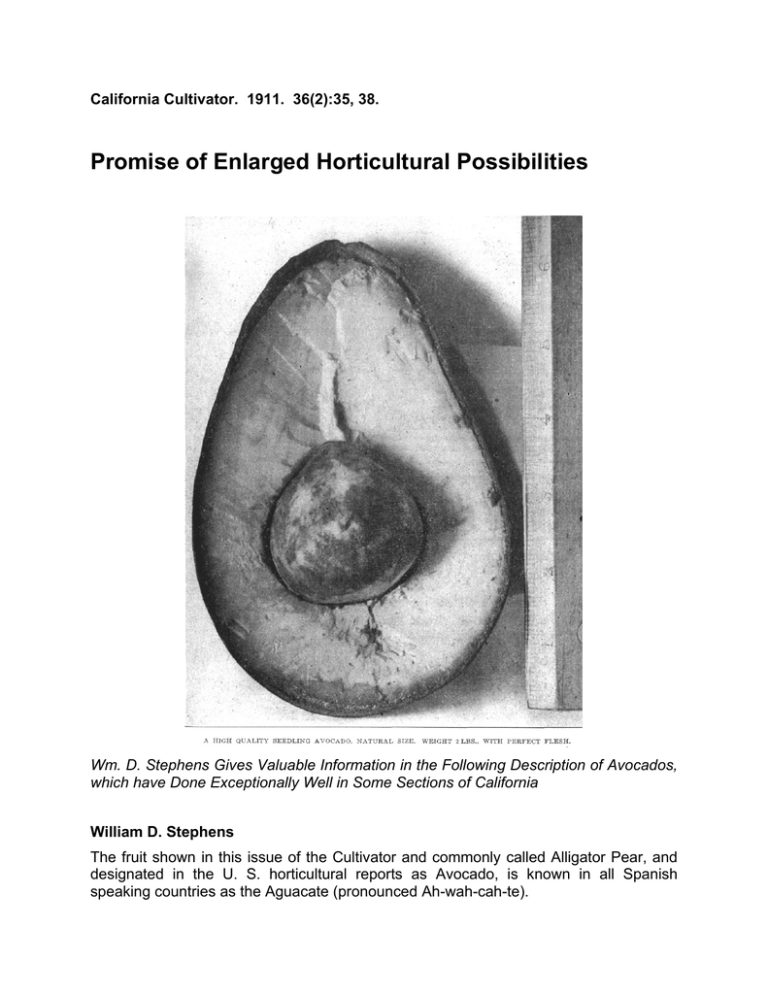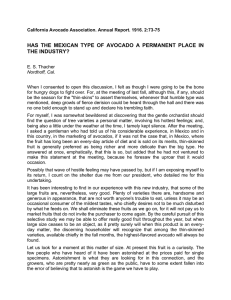Promise of Enlarged Horticultural Possibilities
advertisement

California Cultivator. 1911. 36(2):35, 38. Promise of Enlarged Horticultural Possibilities Wm. D. Stephens Gives Valuable Information in the Following Description of Avocados, which have Done Exceptionally Well in Some Sections of California William D. Stephens The fruit shown in this issue of the Cultivator and commonly called Alligator Pear, and designated in the U. S. horticultural reports as Avocado, is known in all Spanish speaking countries as the Aguacate (pronounced Ah-wah-cah-te). The only portion of the United States where they have been successfully grown, so far as the writer has are the Indian river section in Florida and our own Southern California. It has been the popular belief that they require a practically frostless climate in order to thrive and produce fruit in commercial quantity. In fact, trees grown here from seed imported from Hawaii and the lowlands of Mexico do not appear to withstand any material frosts. On the other hand the tree and fruit are found in their highest state of vigor, productiveness and excellence of quality in the higher altitudes of Mexico where the temperature falls to a point lower than is here believed safe for the growing of citrus fruits, and even where snow usually falls each year. The few trees in California that have reached a producing age and which were grown from seed brought from the high lands in Mexico, have proven that they are at least as hardy and capable of resisting frost as the orange tree. GROUP OF ALLIGATOR PEARS, 11 VARIETIES, WEIGHING 23 POUNDS. The Alligator Pear has more the flavor of a vegetable than a fruit with a heavy oily meat devoid of grain or fiber, pale yellow in color and of a delicious nutty flavor. In color and consistency the meat is not unlike butter and in fact is often termed vegetable butter and eaten in similar way by seasoning with salt and spreading upon bread. It is known to be a very wholesome and nutritious food and nine out of every ten persons tasting become devotedly attached to it if they have the opportunity and a purse that can stand the price they bring in our markets. The writer spent some years in Mexico and is now growing these trees in nursery and orchard in Los Angeles county, and also at Jasmin in the early orange belt in the San Joaquin valley. The fruit shown in the accompanying cuts comes from the mountainous district in the state of Puebla, Mexico, at an altitude of more than 6000 feet, a section noted as producing the finest aguacates in the Republic. The writer has visited many portions of Mexico where they flourish, but has found none that approach in size, flavor or shipping qualities of these Puebla varieties. The writer confidently predicts as great if not an even greater commercial future for this industry in the citrus producing sections of Southern California than that of orange growing. The profits realized by the owners of the few trees here are simply amazing, one tree having produced the present year at least $250 worth of fruit at wholesale prices, and other trees much more than $100 each. The fruit from these local trees it should also be remembered is of small size and ordinary quality, weighing from about one-quarter to one-half pound each. The fifteen fruits shown in grouped picture weighed 23 pounds, the largest one weighing two pounds two ounces and the smallest one pound. The tree producing the two-pound fruit is 80 years old and bears 1500 fruits each year, weighing from one and one-quarter to two and one-quarter pounds. Another fine one shown in single picture is from tree only six years old, bearing 500 fruits weighing about one and one-quarter pounds average. Eleven varieties are shown in the group, all very choice and from all of which the writer is receiving supplies of wood for use in budding the seedling stock in his nurseries. There are numerous aguacate enthusiasts in California who will endorse the writer’s optimistic views as to the great future in store for this new tree food industry. The period of ripening of this fruit by proper selection of varieties may be extended over the twelve months. The better known varieties ripen from October to January, but some others have been found which ripen during the spring and early summer months. With care in picking, the fruit is good for thirty days after taken form the tree. This, together with icing and care in shipping will greatly extend the markets and make profitable great production. Of course it is to be expected that the prices quoted in the Cultivator market columns during the last few months cannot obtain when the fruit is produced in a large way, for if such returns could be secured the profits would be fabulous, but with cultivation put upon the basis of that of citrus fruits, a far lower price would be most profitable. With the extension of markets and the introduction of new varieties which lengthen the season, we do not believe there will be any danger of overproduction. One serous drawback has been the difficulty of propagation of some of the varieties, but improved budding methods have been developed and budders now claim that a percentage of buds may be grown equal to those grown in citrus tree budding. The fruit is now experimentally planted in many sections of the state. In general it has been claimed that where the orange will do well the avocado will be at home.



